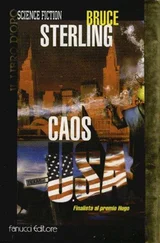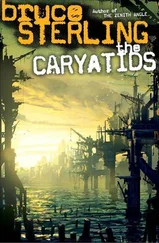Bruce Sterling - The Hacker Crackdown
Здесь есть возможность читать онлайн «Bruce Sterling - The Hacker Crackdown» весь текст электронной книги совершенно бесплатно (целиком полную версию без сокращений). В некоторых случаях можно слушать аудио, скачать через торрент в формате fb2 и присутствует краткое содержание. Жанр: Фантастика и фэнтези, на английском языке. Описание произведения, (предисловие) а так же отзывы посетителей доступны на портале библиотеки ЛибКат.
- Название:The Hacker Crackdown
- Автор:
- Жанр:
- Год:неизвестен
- ISBN:нет данных
- Рейтинг книги:4 / 5. Голосов: 1
-
Избранное:Добавить в избранное
- Отзывы:
-
Ваша оценка:
- 80
- 1
- 2
- 3
- 4
- 5
The Hacker Crackdown: краткое содержание, описание и аннотация
Предлагаем к чтению аннотацию, описание, краткое содержание или предисловие (зависит от того, что написал сам автор книги «The Hacker Crackdown»). Если вы не нашли необходимую информацию о книге — напишите в комментариях, мы постараемся отыскать её.
The Hacker Crackdown — читать онлайн бесплатно полную книгу (весь текст) целиком
Ниже представлен текст книги, разбитый по страницам. Система сохранения места последней прочитанной страницы, позволяет с удобством читать онлайн бесплатно книгу «The Hacker Crackdown», без необходимости каждый раз заново искать на чём Вы остановились. Поставьте закладку, и сможете в любой момент перейти на страницу, на которой закончили чтение.
Интервал:
Закладка:
In February 1989, Prophet and Knight Lightning bargained electronically over the fate of this trophy. Prophet wanted to boast, but, at the same time, scarcely wanted to be caught.
For his part, Knight Lightning was eager to publish as much of the document as he could manage. Knight Lightning was a fledgling political-science major with a particular interest in freedom-of-information issues. He would gladly publish most anything that would reflect glory on the prowess of the underground and embarrass the telcos. However, Knight Lightning himself had contacts in telco security, and sometimes consulted them on material he'd received that might be too dicey for publication.
Prophet and Knight Lightning decided to edit the E911 Document so as to delete most of its identifying traits. First of all, its large "NOT FOR USE OR DISCLOSURE" warning had to go. Then there were other matters. For instance, it listed the office telephone numbers of several BellSouth 911 specialists in Florida. If these phone numbers were published in *Phrack,* the BellSouth employees involved would very likely be hassled by phone phreaks, which would anger BellSouth no end, and pose a definite operational hazard for both Prophet and *Phrack.*
So Knight Lightning cut the Document almost in half, removing the phone numbers and some of the touchier and more specific information. He passed it back electronically to Prophet; Prophet was still nervous, so Knight Lightning cut a bit more. They finally agreed that it was ready to go, and that it would be published in *Phrack* under the pseudonym, "The Eavesdropper."
And this was done on February 25, 1989.
The twenty-fourth issue of *Phrack* featured a chatty interview with co-ed phone-phreak "Chanda Leir," three articles on BITNET and its links to other computer networks, an article on 800 and 900 numbers by "Unknown User," "VaxCat's" article on telco basics (slyly entitled "Lifting Ma Bell's Veil of Secrecy,)" and the usual "Phrack World News."
The News section, with painful irony, featured an extended account of the sentencing of "Shadowhawk," an eighteen-year-old Chicago hacker who had just been put in federal prison by William J. Cook himself.
And then there were the two articles by "The Eavesdropper." The first was the edited E911 Document, now titled "Control Office Administration Of Enhanced 911 Services for Special Services and Major Account Centers." Eavesdropper's second article was a glossary of terms explaining the blizzard of telco acronyms and buzzwords in the E911 Document.
The hapless document was now distributed, in the usual *Phrack* routine, to a good one hundred and fifty sites. Not a hundred and fifty *people,* mind you -- a hundred and fifty *sites,* some of these sites linked to UNIX nodes or bulletin board systems, which themselves had readerships of tens, dozens, even hundreds of people.
This was February 1989. Nothing happened immediately. Summer came, and the Atlanta crew were raided by the Secret Service. Fry Guy was apprehended. Still nothing whatever happened to *Phrack.* Six more issues of *Phrack* came out, 30 in all, more or less on a monthly schedule. Knight Lightning and co-editor Taran King went untouched.
*Phrack* tended to duck and cover whenever the heat came down. During the summer busts of 1987 -- (hacker busts tended to cluster in summer, perhaps because hackers were easier to find at home than in college) -- *Phrack* had ceased publication for several months, and laid low. Several LoD hangers-on had been arrested, but nothing had happened to the *Phrack* crew, the premiere gossips of the underground. In 1988, *Phrack* had been taken over by a new editor, "Crimson Death," a raucous youngster with a taste for anarchy files.
1989, however, looked like a bounty year for the underground. Knight Lightning and his co-editor Taran King took up the reins again, and *Phrack* flourished throughout 1989. Atlanta LoD went down hard in the summer of 1989, but *Phrack* rolled merrily on. Prophet's E911 Document seemed unlikely to cause *Phrack* any trouble. By January 1990, it had been available in *Phrack* for almost a year. Kluepfel and Dalton, officers of Bellcore and AT&T security, had possessed the document for sixteen months -- in fact, they'd had it even before Knight Lightning himself, and had done nothing in particular to stop its distribution. They hadn't even told Rich Andrews or Charles Boykin to erase the copies from their UNIX nodes, Jolnet and Killer.
But then came the monster Martin Luther King Day Crash of January 15, 1990.
A flat three days later, on January 18, four agents showed up at Knight Lightning's fraternity house. One was Timothy Foley, the second Barbara Golden, both of them Secret Service agents from the Chicago office. Also along was a University of Missouri security officer, and Reed Newlin, a security man from Southwestern Bell, the RBOC having jurisdiction over Missouri.
Foley accused Knight Lightning of causing the nationwide crash of the phone system.
Knight Lightning was aghast at this allegation. On the face of it, the suspicion was not entirely implausible -- though Knight Lightning knew that he himself hadn't done it. Plenty of hot-dog hackers had bragged that they could crash the phone system, however. "Shadowhawk," for instance, the Chicago hacker whom William Cook had recently put in jail, had several times boasted on boards that he could "shut down AT&T's public switched network."
And now this event, or something that looked just like it, had actually taken place. The Crash had lit a fire under the Chicago Task Force. And the former fence- sitters at Bellcore and AT&T were now ready to roll. The consensus among telco security -- already horrified by the skill of the BellSouth intruders -- was that the digital underground was out of hand. LoD and *Phrack* must go.
And in publishing Prophet's E911 Document, *Phrack* had provided law enforcement with what appeared to be a powerful legal weapon.
Foley confronted Knight Lightning about the E911 Document.
Knight Lightning was cowed. He immediately began "cooperating fully" in the usual tradition of the digital underground.
He gave Foley a complete run of *Phrack,*printed out in a set of three-ring binders. He handed over his electronic mailing list of *Phrack* subscribers. Knight Lightning was grilled for four hours by Foley and his cohorts. Knight Lightning admitted that Prophet had passed him the E911 Document, and he admitted that he had known it was stolen booty from a hacker raid on a telephone company. Knight Lightning signed a statement to this effect, and agreed, in writing, to cooperate with investigators.
Next day -- January 19, 1990, a Friday -- the Secret Service returned with a search warrant, and thoroughly searched Knight Lightning's upstairs room in the fraternity house. They took all his floppy disks, though, interestingly, they left Knight Lightning in possession of both his computer and his modem. (The computer had no hard disk, and in Foley's judgement was not a store of evidence.) But this was a very minor bright spot among Knight Lightning's rapidly multiplying troubles. By this time, Knight Lightning was in plenty of hot water, not only with federal police, prosecutors, telco investigators, and university security, but with the elders of his own campus fraternity, who were outraged to think that they had been unwittingly harboring a federal computer-criminal.
On Monday, Knight Lightning was summoned to Chicago, where he was further grilled by Foley and USSS veteran agent Barbara Golden, this time with an attorney present. And on Tuesday, he was formally indicted by a federal grand jury.
The trial of Knight Lightning, which occurred on July 24-27, 1990, was the crucial show-trial of the Hacker Crackdown. We will examine the trial at some length in Part Four of this book.
Читать дальшеИнтервал:
Закладка:
Похожие книги на «The Hacker Crackdown»
Представляем Вашему вниманию похожие книги на «The Hacker Crackdown» списком для выбора. Мы отобрали схожую по названию и смыслу литературу в надежде предоставить читателям больше вариантов отыскать новые, интересные, ещё непрочитанные произведения.
Обсуждение, отзывы о книге «The Hacker Crackdown» и просто собственные мнения читателей. Оставьте ваши комментарии, напишите, что Вы думаете о произведении, его смысле или главных героях. Укажите что конкретно понравилось, а что нет, и почему Вы так считаете.



